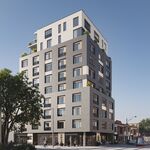Finch West and Sheppard East would have been far longer lines than the proposed Sheppard subway. What's the definition of 'piecemeal'?
I wasn't talking about the Sheppard Subway, I was talking about the Eglinton Crosstown.
But you haven't quantified them or demonstrated how they are worth $2 billion+. I realize those are benefits, but there is a financial trade-off in play and that's what matters in this age of counting every nickel and dime.
Sorry, but I don't have the necessary financing or data to undertake a study like that.
I believe the current plan for Eglinton was to be able to run two or three car trains. Is there a need for longer trains?
There may very well be down the road, especially if it's interlined with the SLRT, which on its own will be needing 4 car LRT trainsets.
With the median ROW and next to no left turns (unlike St Clair), how many accidents would there be? How often have pedestrians been a problem on St Clair?
Just look at how many accidents happen in the intersections along Eglinton between Don Mills and Kennedy, and Jane and Martin Grove. Every one of those accidents that occurs inside the intersection would cause a delay on the line.
What would be the performance improvement by running the current surface sections ATC? Would that be worth the Sheppard and Finch lines?
AFAIK, you can't even run ATC at-grade in-median, because of the dangers associated with foreign objects crossing in front of the train (people, cars, etc).
Are you stating that bus lanes as you suggest would result in the same level of local development that surface LRT would?
York Region seems to be banking on it. Look at the renderings they have for some of their VIVA projects.
What would be your additional operating cost of needing more buses and drivers to meet the capacity of the LRT lines?
The cost of not having to buy the new LRT trains, the cost of not having to build a separate storage facility for the LRT trains, and the cost of not having to spend double on the actual construction
In any case, you're arguing against BRT because of the increased operating costs, but are completely discounting the fact that LRT costs TWICE AS MUCH TO BUILD compared to BRT. Penny wise, pound foolish!
What practical increases in demand could those bus lanes tolerate beyond that which currently exists (particularly the Finch West line)?
Certainly more than the projected riderships on both lines. The 407 Transitway is targetting well over 10,000 pphpd. Bus lanes in Ottawa carry well over the 5,000 pphpd that is forecast for Finch.
Maybe you missed the point previously stated that Finch West and Sheppard East were targeted to serve the significantly underserved areas of northern Etobicoke and Scarborough respectively. The proposed Sheppard subway line does neither.
Again, I wasn't talking about the Sheppard Subway, I was talking about the Eglinton Crosstown. And maybe you missed the point where I was saying that if you were really concerned about delivering cost-effective service to these neighbourhoods, you'd realize that given the projected riderships, BRT would do just as good of a job as LRT, for significantly less cost.
Because we all know that the Sheppard subway either won't get built at all or will be a huge bill dumped on the Toronto taxpayer. The previous plan was for more people being served by a line paid for by the province. That is purely due to Ford and his 'plan to have a plan'.
Did I ever say I supported Ford's vision of the Sheppard Subway?




